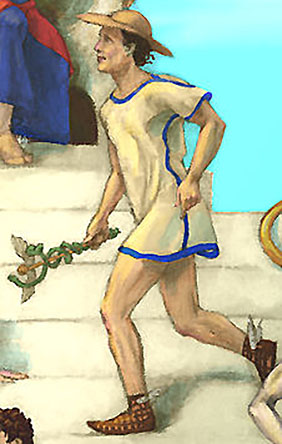The word hermeneutic is possibly the ugliest word ever invented.
To a modernist it means two contradictory statements that can be allowed to stand as equivalent by introducing a peculiar understanding.
Named after the Greek demon that symbolized ambiguity and held out the alchemical lie of gold from garbage, it is a promise kept alive by gnostic mystery cults up through the openly satanic secret societies of the present
I did some checking and the most common factor in the descriptions of
Hermes is that it was his job to conduct departed souls to the underworld.
That sounds a lot to me like taking your a** to hell. But I did not copy
any of those references below. I'm looking for this other thing...
I'd like to know where this comes from: "two contradictory statements
that can be allowed to stand as equivalent by introducing a peculiar
understanding." From the information below, the only clue I see is the
caduceus:
"Hermes' symbol of office as divine messenger was his staff, or caduceus. This was originally a willow wand with entwined ribbons, traditional badge of the herald. But the ribbons were eventually depicted as snakes."
This appears to be the derivation of the logo that the AMA uses for
physicians:

This may be explained by this entry for caduceus in
Mythological Dictionary:
caduceus
In Latin the herald's staff was known as the caduceum, derived from the Greek word keryx or herald, and his staff the kerykeion. Hermes, as divine messenger, was invariably depicted with the caduceus, which was represented as a staff with white ribbons or intertwined snakes. The white ribbons may have indicated the inviolability of his office. The image of intertwined snake may have been drawn from the near eastern use of copulating snakes as a symbol of fertility, for Hermes was a fertility god. The staff of Hermes became confused with the staff of Asclepius, the renowned mythic physician and son of Apollo because some stories about Asclepius involved snakes and the reptile has the ability to slough its old skin and seemingly be "reborn," and so had associations with healing.
A website page -
Hermeneutic.org - begins thus:
Hermeneutic
Hermeneutic ˌhər-mə-ˈnü-tik, Hermeneutical ˌhər-mə-ˈnü-ti-kəl, a. [Greek 'ερμηνεύς, to interpret: cf. F. herméneutique.] Unfolding the signification; of or pertaining to interpretation; exegetical; explanatory; as, hermeneutic theology, or the art of expounding the Scriptures; a hermeneutic phrase. From Hermes [Greek Ἑρμῆς] the messenger of the gods.
It goes on to give references it relates to Maimonides, who promoted
charitable giving.

Another site has this, regarding the mythology of Hermes:
HERMES (HUR-meez; Roman name Mercury) was the messenger of the gods and
guide of dead souls to the Underworld. A prankster and inventive genius from birth, Hermes aided the heroes Odysseus and Perseus in their quests.
Hermes was the son Zeus and a mountain nymph. As a newborn he was remarkably precocious. On his very first day of life, he found the empty shell of a tortoise and perceived its utility as a sounding chamber. Stringing sinews across it, he created the first lyre.
Hermes was known for his helpfulness to mankind, both in his capacity as immortal herald and on his own initiative. When Perseus set out to face the Gorgon Medusa, Hermes aided him in the quest. According to one version of the myth, he loaned the hero his own magic sandals, which conferred upon the wearer the ability to fly.
Some say that Hermes loaned Perseus a helmet of invisibility as well. Also known as the helmet of darkness, this was the same headgear that Hermes himself had worn when he vanquished the giant Hippolytus. This was on the occasion when the gargantuan sons of Earth rose up in revolt against the gods of Olympus.
Hermes' symbol of office as divine messenger was his staff, or caduceus. This was originally a willow wand with entwined ribbons, traditional badge of the herald. But the ribbons were eventually depicted as snakes. To support this mythologically, a story evolved that
Hermes used the caduceus to separate two fighting snakes which forthwith twined themselves together in peace.
It was Hermes' job to convey dead souls to the Underworld. And as patron of travelers, he was often shown in a wide-brimmed sun hat of straw. Hermes was known to the Romans as Mercury. His most famous depiction, a statue by Bellini, shows him alight on one foot, wings at his heels, the snaky caduceus in hand and, on his head, a rather stylized combination helmet-of-darkness and sun hat.

I have heard it explained that B16's endearment with the term
"hermeneutic" is based in his fascination with Jєωιѕн doctrines or the
the teachings of certain rabbis. I cannot verify this, however. Nor do
I recall the source: something I heard that impressed me, is all I can
say.
I do recall a sermon of Fr. Pfeiffer recently that contains a story of two
bishops who cannot see eye-to-eye. They disagree. They disagree over
the subject matter of light bulbs. One hates light bulbs ("I
hate light
bulbs!"). And the other loves light bulbs ("I
love light bulbs!"). There
is no way for these two bishops to get along, but they have a desire to
make peace with each other. Along comes a wise man, who tells them,
"I kin shows you how you kin b'come friends. Alls y'all need-a-do is, say:
'Ah'm near a light bulb,' and y'all kin be friends." So the bishop who hates
light bulbs ("I
hate light bulbs") and the bishop who loves light bulbs
("But I
love light bulbs") both say, "I am
near a light bulb." And they
become friends.